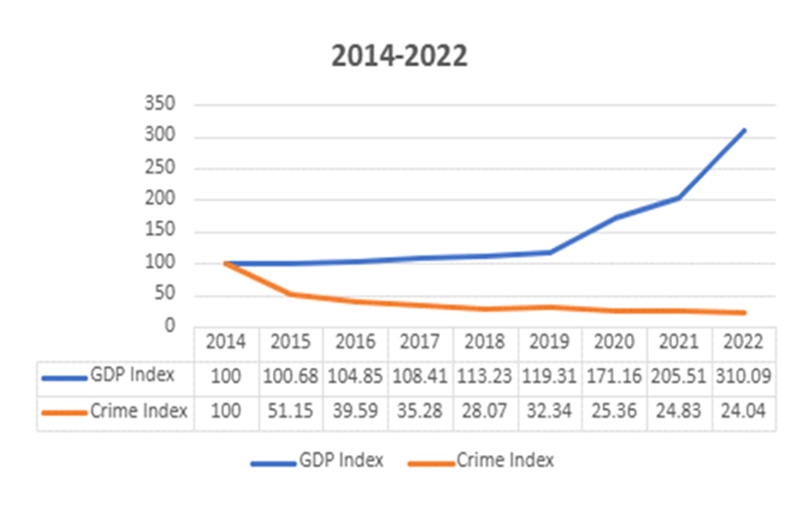
Dear Editor,
THERE is a popular theory that expanding economic development would lead to a decrease in criminality through making available several opportunities for jobs, housing, medical care/access, social and occupational mobility, and other forms of empowerment.
However, as attractive as this theory might appear, it has not worked for some countries, like the USA, that have experienced increasing crime with expanding economic development. I sought to explore, therefore, if this theory could apply to Guyana. An analysis covering the period 2014 to 2022 shows that expanding economic development has not led to an increase in criminality.
As Guyana advances in its development thrust, the incidence of serious crimes reported to the police has been declining after 2014, while the GDP has been expanding rapidly from 2019 partly because of oil production and revenues.
The chart shows the relationship between economic development as measured by GDP and crime. An index for crime and GDP was created using 2014 as the base to allow for comparison.
I utilised the Pearson’s correlation coefficient (r) to determine if there is any relationship between expanding economic development and an increase or decrease in criminality.
The existing data show a negative but weak correlation (r -0.452, not significant P<.05). As GDP increased, crime moved negatively in the opposite direction, that is, it declined from 2015 to 2022.
Property crimes (burglary, larceny, robbery), for example, had declined by 28.9 per cent from 2019 to 2022, while crimes of passion (murder, wounding, rape) showed a slight increase of 1.5 per cent for the same period.
One might also want to contend that GDP growth is not necessarily a good indicator of economic development.
Well, to augment the GDP, the UNDP’s Human Development Index (HDI) has been referenced. Guyana scored 0.65 in 2017 (medium development) but three years later (2020), its HDI score increased by 10.9 per cent to 0.721 thus making the country a “high human development” category.
Guyana shares the same HDI category as Jamaica and Suriname, but falls below Trinidad and Tobago with a HDI score of 0.81 (very high). In 2021, there was a slight drop in Guyana’s HDI index. A perfect HDI score is 1.0.
With massive spending on education, health, housing, water, infrastructure, and job creation the HDI index is expected to rise above the 2020 level in 2023. These data indicate that economic development and human development exist in a symbiotic relationship, and that GDP could indeed be utilised as a genuine indicator of economic development. (The HDI is compiled by UNDP and is based on three indicators: (I) long and healthy life, (2) access to knowledge, and (3) decent standard of living.
While there is a weak negative relationship between GDP and crime in Guyana, this should not obscure the reality that certain types of crime, like rape, stir the conscience of people, and when its incidence rose by 83 per cent between 2019 and 2021, that could not offer any solace to citizens.
A sigh of relief occurred when it was reported that the incidence of rape declined by 23.7 per cent in 2022. But the 2022 figure was still high (N=255). The incidence of wife murders also rattles the nation and does not paint a good picture of social control methods deployed by the authorities.
Murders are integral to the domestic violence situation. Often role conflicts and infidelity are the main precipitatory factors of domestic violence.
While economic development has not led to an increase in criminality so far, it is difficult to predict if this condition will persist into the future and for how long.
Keeping crime under control would depend on several factors: (1) economic: implementation of policies for reduction in poverty and unemployment, empowerment programs; (2) psychological: reduction of hopelessness and reduction of relative deprivation; (3) social: the effectiveness of rehabilitation/reform programmes: (4) law enforcement: the quality of policing and law enforcement; and (5) societal response: the level of tolerance for crime and the effectiveness of the partnership between policing and community groups. Public safety must always be a top priority.
Sincerely
Dr Tara Singh




.jpg)










